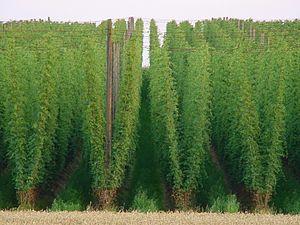
Deutsch: Hopfengarten (Humulus lupulus) nahe Au in der Hallertau (Photo credit: Wikipedia)
Even though it only has four main ingredients, beer is an infinitely diverse beverage. I n skilled hands,, those four ingredients – water, malt, yeast, and hops – can be combined to create anything from a light, crisp pilsner to a thick and hearty stout. In between those two extremes are hundreds of styles and variations. Add in a variety of adjuncts, and the possibilities become astronomical.
But, beer did not always have all four of the main ingredients that we enjoy in the modern brew. In fact, one of the most famous beer purity laws, the German Reinheitsgebot, originally identified only three ingredients – water, malt, and hops when it was first enacted in 1516. The law was later amended when yeast was discovered by Louis Pasture in the late 1800s.
Still, there is one ingredient in what we know as beer that was not always a staple. That ingredient is hops. Used to add the characteristic bitterness inherent in many beers, hops are a relatively new addition to a beverage that has been with humanity since the very beginning of civilization. Tests of pieces of pottery found in modern day Iran have produced evidence that a fermented grain drink was produced and enjoyed over 7,000 years ago.
The first brews were thought to be rather simple concoctions of crushed grains and water that were left outside to ferment. Of course, the makers of these early brews had no idea that by leaving these early beers out in the open air, they were being spontaneously inoculated by wild yeast and thus the process of fermentation had begun. And, those first brewmasters had no idea about the flavor enhancing properties of hops.
It is not until 77 AD that hops are even mentioned in any historical text. And even then, the references to the plant were not connected to brewing. The first descriptions of the plant were more like botanical cataloging and were recorded by Pliney the Elder of the naturally occurring plant. The first written record of humans cultivating the plant does not appear until 736 AD nearly 660 years later. And it is another 82 years until the first known reference to hops being used in beer.
Contrary to popular belief, hops were not first used in beer by early Germans; instead it was the French that added the bitter cones to their brews first. The Germans were nearly 300 years behind. The key text that points to this is written by Abbot Adalhard of the Benedictine monastery of Corbie. In statutes that spell out how to run the monastery, the Abbot specifically mentions that hops gathered in the wild are to be given to the porter for the making of beer.
Since the introduction of hops into beer, things have never been the same. Hops, with their natural preservative properties, are responsible for the development of many of today’s favorite beer styles. The English introduced copious amounts of hops into ales that were shipped to India in order for the beer to arrive unspoiled bringing the world IPAs. Pilsners get their delicious crisp, dry flavor from the addition of hops. And, Imperial stouts get their impressive and deeply satisfying wallop from the bitter cones, too.
Depending on the flavors a brewer wants to impart to his brew, he or she will chose from the wide variety of hops. There are hops that will add citrusy flavors, piney flavors, and vegetal flavors. There are hops that are added specifically for the aroma they bring to a brew and there are hops that are used to add pleasant floral or fruity notes to beer. The bottom line is that brewers have a wide variety of hops to choose from both for bittering and aroma. In the right hands, this simple plant can be used to elevate a mediocre beer to heights that can only be described stratospherically.
